
Parisian macarons are the sort of tempting, tantalizing dessert that many people love to look at, but would never dare to try at home.
The reason is not always the challenge, but because of all of the prerequisites needed before you can even begin. You need to buy almond flour, you need a kitchen scale, you need a piping bag; the list gets so long and daunting that some home bakers can't invest in all the fancy do-das necessary just to try a dessert they may have never even eaten before.
Maybe you can't manage to bake macarons the "right way", but what if there were a short cut?
I can't say it will be an easier way. It is far easier to make macarons when following the correct method with all of the necessary equipment. But if you want to put macarons on your plate as hassle-free as possible, here are a few tips for your shortcut route.
No Almond Flour:
Make your own! Almond flour, with brands like Bob's Red Mill, is generally available for purchase at grocery stores and health food stores, but some smaller grocery stores don't have a health food/gluten-free aisle making the flour hard to come by without ordering online. Cost of shipping, plus the higher cost of a pound of almond flour, can sometimes deter home bakers from ever picking up the spatula and attempt macarons at home. The easiest alternative is to make your own almond flour.
2. Empty food processor and sift almond. Put larger pieces through food processor a second time. Sift and repeat as necessary.
3. Pulse all almond flour briefly with blade attachment to remove any remaining larger pieces. Don't pulse too long or the almond flour will start to clump and will eventually turn into almond butter.
4. Store in sealed container in refrigerator until needed.
4. Store in sealed container in refrigerator until needed.
5. If your almond flour is too moist or clumping, throw it on a flat baking sheet in the oven at 200°F for 30 minutes.
6. Pulse almond flour in food processor again with confectioner's sugar when preparing for a batch of macarons.
No Scale:
Use volume measurements. First, I do recommend buying a scale. I cannot tell you in words how much I recommend buying a scale, so let me show you in picture form.
This is what can become of your macarons if you try translating weight to volume measurements. The process can be inaccurate because different ingredients of the same weight value take up more or less space. Your life is going to be so much more difficult if you try to live without a scale. All you need is a cheap little thingamabob that measures in grams, like this one I got from Biggest Loser for $20.
If you spent your last dime on almond flour and can't afford to splurge on a kitchen scale, then you can get by following volume measurements specific to each ingredient.
Be careful to be as exact as possible when measuring your ingredients. The egg whites are especially tricky since different grades of egg will each have a different volume. The average large Grade A egg white is 30 - 33 grams. If you're using eggs from a local organic farm or from your backyard chickens, all bets are off!
To help you out, I've weighed and then measured the volume of my ingredients for a batch of macs. Follow the conversion carefully and you will be able to make macarons without a kitchen scale.
No Food Processor:
Sift by hand. The food processor is normally used to sift together confectioner's sugar with the almond flour to ensure that it's evenly mixed and that the almond flour does not have any large clumps. If you do not have a food processor, you will have to sift together the ingredients by hand and use a strainer to catch any larger clumps.
No Stand Mixer:
Mix by hand or hand mixer. There is no rule that you have to use a stand mixer when making meringues -- it's just a lot easier. The next best option would be to use an electric hand mixer instead at the same settings and time as a stand mixer.
If you do not have an electric option, you can whip a meringue with a whisk as our foremothers have done before us, but bring your muscles to the table and maybe have backup ready in case you get a cramp.
No Silicone Mats:
Use parchment paper. As I mentioned in the tutorial earlier this month, some bakers actually swear old-fashioned parchment paper is better than fancy reusable silicone mats. I find both work about the same, so you don't have to buy silicone mats unless you prefer to recycle or not buy a ton of parchment paper.
More importantly, I will warn that you are never, under any circumstances, to use wax paper or aluminum foil as a replacement. Remember how I said I wasn't all that familiar with baking and cooking a few years ago? When I baked my first batch of macs, I had never come across a circumstance where wax or parchment paper actually made a difference, so I used wax paper. They fused together like melted crayons and there was no rescuing that batch.
No Piping Tips or Bags:
Use plastic bags. While piping tips are useful for creating perfectly circular macarons, they are not necessary. Any gallon- or quart-sized plastic bag (like a Ziploc) will work just as well.
Simply, fill one corner of the plastic bag with macaron batter.
Twist and close off the open end of the bag, like you would a piping bag.
When ready to pipe, use a scissors to cut open a 1/2 - 3/4 inch opening across the corner. Squeeze the batter out of the bag onto the baking sheet. Dispose of bag when done.
No Ruffled Feet:
Use a macaron baking mold? Today's post is all about getting by when you are without while making macarons so this is a bit of a deviation, but I wanted to share about a recent development in the macaron world. Macaron baking molds, such as this Mastrad model or this Freshware silicone model, work based on the idea of physically constricting the macaron batter into the trademark smooth domed shape with ruffled feet.
Now, I haven't tried these baking pans yet, but they are an option if you're afraid your macarons won't have the perfect shape. However, I find this idea to be kind of like phone fingers: sure it will solve the problem of finger prints on your phone, but is that really a problem so important that you're willing to look a bit silly? If you want to learn how to bake macarons, then doing the process correctly will create ruffled macaron shells all on it's own. You really won't need a special pan mold. Besides, no self-respecting patisserie would use a macaron pan, so you'll look a bit silly.
No Gel or Paste Food Coloring:
Use liquid. Gel and paste food coloring creates the brightest hues of color, but they are often only available at specialty baking or craft stores or online. For a quick fix, grab liquid food coloring available at nearly all grocery stores. If you're stranded in a dessert and that's not an option, macarons don't have to have bright colors. They naturally bake to a warm tan color and they taste just as good.
Rating of Difficulty: 4 out of 5. Remember that these shortcuts may be less exact, so don't be discouraged if your macaron is less-than-perfect. I promise, they will still taste delightful!
6. Pulse almond flour in food processor again with confectioner's sugar when preparing for a batch of macarons.
No Scale:
Use volume measurements. First, I do recommend buying a scale. I cannot tell you in words how much I recommend buying a scale, so let me show you in picture form.
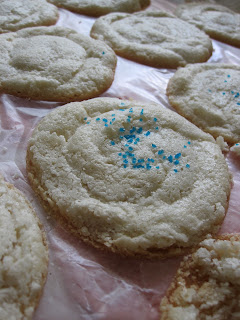 |
| My first batch of macarons that went wrong in every possible way! |
If you spent your last dime on almond flour and can't afford to splurge on a kitchen scale, then you can get by following volume measurements specific to each ingredient.
Be careful to be as exact as possible when measuring your ingredients. The egg whites are especially tricky since different grades of egg will each have a different volume. The average large Grade A egg white is 30 - 33 grams. If you're using eggs from a local organic farm or from your backyard chickens, all bets are off!
To help you out, I've weighed and then measured the volume of my ingredients for a batch of macs. Follow the conversion carefully and you will be able to make macarons without a kitchen scale.
No Food Processor:
Sift by hand. The food processor is normally used to sift together confectioner's sugar with the almond flour to ensure that it's evenly mixed and that the almond flour does not have any large clumps. If you do not have a food processor, you will have to sift together the ingredients by hand and use a strainer to catch any larger clumps.
No Stand Mixer:
Mix by hand or hand mixer. There is no rule that you have to use a stand mixer when making meringues -- it's just a lot easier. The next best option would be to use an electric hand mixer instead at the same settings and time as a stand mixer.
If you do not have an electric option, you can whip a meringue with a whisk as our foremothers have done before us, but bring your muscles to the table and maybe have backup ready in case you get a cramp.
No Silicone Mats:
Use parchment paper. As I mentioned in the tutorial earlier this month, some bakers actually swear old-fashioned parchment paper is better than fancy reusable silicone mats. I find both work about the same, so you don't have to buy silicone mats unless you prefer to recycle or not buy a ton of parchment paper.
More importantly, I will warn that you are never, under any circumstances, to use wax paper or aluminum foil as a replacement. Remember how I said I wasn't all that familiar with baking and cooking a few years ago? When I baked my first batch of macs, I had never come across a circumstance where wax or parchment paper actually made a difference, so I used wax paper. They fused together like melted crayons and there was no rescuing that batch.
No Piping Tips or Bags:
Use plastic bags. While piping tips are useful for creating perfectly circular macarons, they are not necessary. Any gallon- or quart-sized plastic bag (like a Ziploc) will work just as well.
Simply, fill one corner of the plastic bag with macaron batter.
Twist and close off the open end of the bag, like you would a piping bag.
When ready to pipe, use a scissors to cut open a 1/2 - 3/4 inch opening across the corner. Squeeze the batter out of the bag onto the baking sheet. Dispose of bag when done.
No Ruffled Feet:
Use a macaron baking mold? Today's post is all about getting by when you are without while making macarons so this is a bit of a deviation, but I wanted to share about a recent development in the macaron world. Macaron baking molds, such as this Mastrad model or this Freshware silicone model, work based on the idea of physically constricting the macaron batter into the trademark smooth domed shape with ruffled feet.
Now, I haven't tried these baking pans yet, but they are an option if you're afraid your macarons won't have the perfect shape. However, I find this idea to be kind of like phone fingers: sure it will solve the problem of finger prints on your phone, but is that really a problem so important that you're willing to look a bit silly? If you want to learn how to bake macarons, then doing the process correctly will create ruffled macaron shells all on it's own. You really won't need a special pan mold. Besides, no self-respecting patisserie would use a macaron pan, so you'll look a bit silly.
No Sugar:
No Macarons! Some health-conscious bakers have attempted to make sugar-free macarons or reduced sugar macarons. While it is possible to make macaron-like cookies with sugar substitutes or less sugar, the characteristics of the macaron will change substantially. It's like comparing water color to acrylic: sure they're both paint, but they won't have the same qualities or work for the same purposes.
So I recommend sticking with real sugar. Macarons are rich European desserts, which means that one or two is usually more than enough to satisfy your craving. Moderation is a healthier option than downing a whole bag of peanut butter cups after all. If you can't stop yourself from eating the whole dozen macarons, invite some friends over and share. They'll love you forever!
No Gel or Paste Food Coloring:
Use liquid. Gel and paste food coloring creates the brightest hues of color, but they are often only available at specialty baking or craft stores or online. For a quick fix, grab liquid food coloring available at nearly all grocery stores. If you're stranded in a dessert and that's not an option, macarons don't have to have bright colors. They naturally bake to a warm tan color and they taste just as good.
Flavor:
Use what you have. Liquid flavor extracts are easier, but pretty much anything can be used for filling in macarons. Check through your pantry. If you have fresh fruit, jams, premade icing, peanut butter, or melting chocolate, you can make a macaron.
On that note, let's bake some macarons! I had some blueberries in the fridge, so let's throw them in macarons.
Blueberry & Buttercream Macaron Recipe
2 cups confectioner's sugar
1 1/3 cup almond flour, ground with food processor
1/3 cup granulated sugar
1/2 cup egg whites (room temperature)
pinch of cream of tartar
4 drops of blue liquid food coloring or 1/4 tsp powder food coloring
1/2 cup granulated sugar
2 large egg whites
1/2 cup unsalted butter (room temperature)
pinch of salt
2 cups of fresh blueberries
2 cups of fresh blueberries
1. Preheat oven to 325°F. Sift almond flour and confectioner's sugar together in bowl to combine ingredients and to remove any large clumps.
2. Whip egg whites at medium speed in mixer with whip attachment until foamy and wires of beater leave trails (1 - 2 minutes).
3. Add a pinch of tartar (optional). Continue to whip and add 1 Tbsp of granulated sugar every 30 - 45 seconds until all 80 grams have been added. Continue whipping until meringue turns glossy and stiff in about 4 - 8 minutes. If you remove the whisk and turn it upside down, your meringue should form a stiff peak.
3. Add a pinch of tartar (optional). Continue to whip and add 1 Tbsp of granulated sugar every 30 - 45 seconds until all 80 grams have been added. Continue whipping until meringue turns glossy and stiff in about 4 - 8 minutes. If you remove the whisk and turn it upside down, your meringue should form a stiff peak.
4. Combine half of the almond flour/sugar mixture with the meringue and mix it gently with a rubber spatula. Add the second half of the almond flour/sugar mixture and food coloring, if desired, and gently mix to combine batter.
5. Pipe batter using a plastic bag into small circles onto baking sheet lined with parchment paper. Tap baking sheets against the table to release air bubbles.
6. Let the batter rest for 30 minutes until shell is dried and no longer tacky.
7. Bake at 300°F for 15 - 20 minutes until macaron is baked solid. Let cool.
8. Whisk sugar and egg whites together until combined in a glass bowl over a sauce pan of boiling water at medium high heat. Whisk occasionally while simmering until mixture is hot to touch (4 - 6 minutes).
9. Remove from heat and transfer to a stand mixer fitted with a whisk.
10. Whip at medium speed until mix becomes light white and cool to touch (4 - 6 minutes).
11. Reduce speed to low and add butter in small slices. Mix at medium speed until smooth. Add a pinch of salt.
12. Pipe buttercream filling onto each macaron cookie, add a layer of blueberries, another layer of buttercream, and combine with another macaron of equal size to form a sandwich.
So now you have no excuses: you can bake macarons at home! Enjoy!
Linking at:





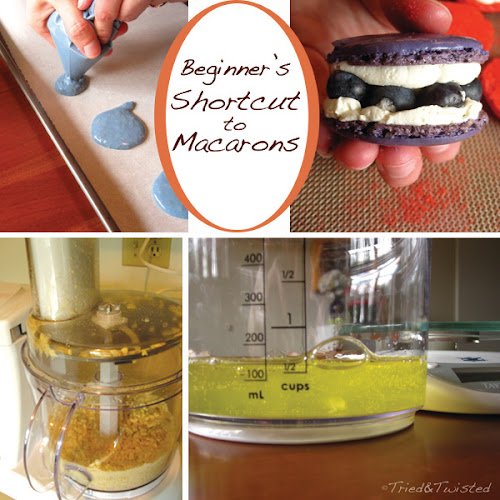
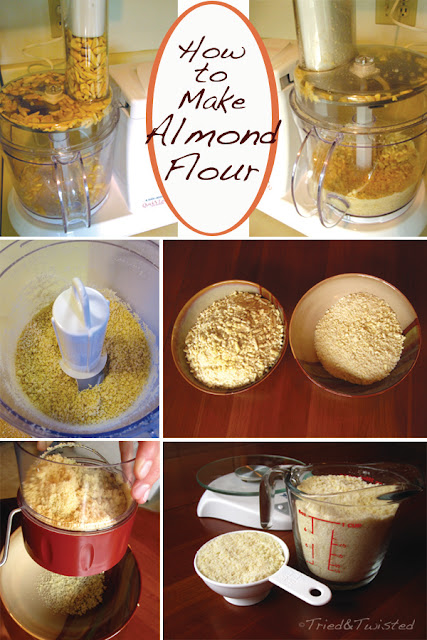
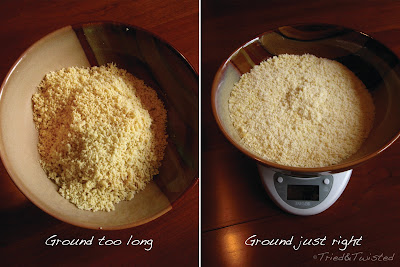



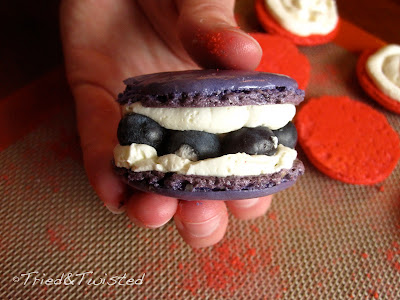


Great recipes and tips! Thanks so much for linking up to Give Me The Goods Monday! Can't wait to see what goods you bring next week! Jenna @ Rain on a Tin Roof
ReplyDeleteThank you! You throw a great link party.
DeleteHi! Is it safe to use fresh blueberries to make the macarons (not the filling)?
ReplyDeleteHi Evelyn, I have not tried fresh blueberries, but I would guess that fresh blueberries would add too much moisture to the batter if they were mixed in and make the shells too runny. If you give it a try, I'd love to hear how it turns out.
DeleteDehydrated blueberries might work better, but when I tried that with dehydrated strawberries, the flavor was very subtle. It does take extra effort to dry the strawberries in the oven and blend them, but that could be worth a try.
Best of luck!
- Sara